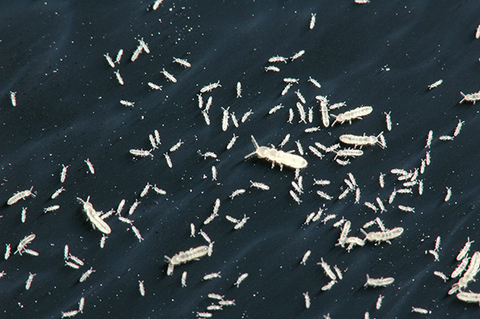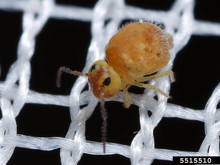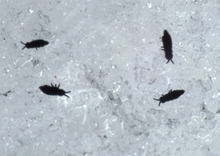Quick facts
- Springtails are found in areas of high moisture and in organic debris.
- They can be annoying but do not damage food, clothes, furniture or property.
- Springtails do not bite or sting and are harmless to people and animals.
- They feed on decaying roots and fungi and rarely damage plants.
- Moisture control is the most effective option for controlling springtails.
How to tell springtails from other small insects
Most springtails are dark-colored, brown, grey or black. Some species may be white and some are even brightly colored.
- Usually slender, elongated insects, but there is a group that is round and stout.
- Very small, between 1/16th and 1/8th inch long.
- Moderate length antennae.
Springtails do not have wings and cannot fly. But they can jump up to several inches using a special forked structure under the abdomen.
Springtails and fleas may be the same size but have differences in their structure.
- Fleas are flattened from side to side and have very hard bodies, making them difficult to kill by crushing.
- Springtails have a more rounded, soft body and are easily crushed.
Biology
Indoors
- Find springtails in areas of high moisture and condensation (around plumbing leaks in bathrooms, basements and kitchens).
- Springtails are commonly found in the soil of overwatered houseplants.
- They prefer soil that is excessively damp or soil mixes that contain a high percentage of peat.
Outdoors
- Outdoors, springtails can be found feeding on fungi, pollen, algae or decaying organic matter, often on or in the soil.
- You can find lots of springtails in mulch.
- Some species of springtail feed on living plants, especially the leaves of young plants.
- Damage can appear as a series of tiny holes in the leaf.
- Leaf-feeding damage is typically very minimal.
Springtails in winter
- Snow flea (Hypogastruna nivicola) is a springtail species that is active during winter and seen on snow.
- Snow fleas become active as soon as the ground begins to thaw in late winter or very early spring.
- They are generally found in groups and their dark-colored bodies are easily noticed against white snow.
Managing springtails in homes and gardens
When you see large numbers of springtails, it means there is a high moisture problem. Springtails are generally a temporary problem and die when moisture levels are reduced.
In homes
Check for moisture problems inside and outside of the house.
Moisture-causing issues:
- Rain spouts that do not carry water far enough away from the foundation.
- Landscapes that slope towards buildings.
- Excessive irrigation.
- Non-functioning drainage systems around the building.
- Plumbing leaks inside the home.
If you see small numbers of springtails, ignore them or physically remove them by hand or with a vacuum. For larger infestations:
- Dry out wet areas with a fan or dehumidifier.
- Remove wet wood, especially if it is moldy.
- Make structural changes to correct moisture problems.
- Remove or reduce the amount of mulch around the foundation of your home.
If you have a problem with springtails in houseplants, let the soil dry out and water less frequently but more deeply.
Pesticides are not effective against springtails and should not be used inside the home for these insects.
In gardens
- Damage is minor enough to not be of concern.
- If you are seeing lots of damage, reduce the amount of decaying plant matter in the garden before planting next year.
- Most pesticides are not effective against springtails, and damage is minor enough to not warrant their use.
Managing springtails on farms
Cultural controls
Springtails feed on organic matter, so if you are seeing consistent springtail damage, avoid planting into fields with high levels of crop residue or recently terminated cover crops.
Using insecticides
- Pesticides are generally not necessary for springtail management as damage is so sporadic.
- Many products with springtails on the label are for turf or ornamental plants, not vegetables for field crops.
- Capinera, J.L. 2001. Handbook of Vegetable Pests. Academic Press, San Diego, CA.
- Cranshaw, W. 2004. Garden Insects of North America: the Ultimate Guide to Backyard
- Bugs. Princeton University Press, Princeton, NJ.
- Evans, H.E. 1968. Life on a little-known planet. E.P. Dutton & Co., New York, NY.
- Shetlar, David J. & Jennifer E. Andon. 2015. Springtails. Ohio State University Extension Fact Sheet. HYG-2070-98. https://ohioline.osu.edu/factsheet/ENT-52/
Reviewed in 2024





